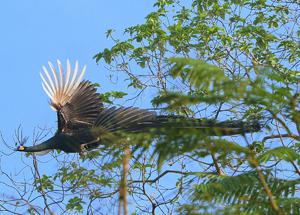Thiri Dae We Aung
The aims of the project are to estimate the population in a particular habitat within a particular period and to update the population status of that species in central Myanmar.

Green Peafowl's egg. © Dr. Thein Aung.
Green Peafowl used to be common in Myanmar during the last 30 to 40 years. It was found in the North, West, and South and in central Myanmar. Whenever one asked a local hunter almost every hunter seemed to know where to find that species and are willing to show the roosting place. In these areas calls of Green Peafowl were always heard in early mornings and late afternoons. Because of that everyone took it for granted that its status was not threatened and did not need special attention. Therefore no ornithologists had studied population status of Green Peafowl in our country. No one has ever thought it would become an endangered species as quickly as now.

Green Peafowl. © Kyaw Myo Naing.
The decline of the Green Peafowl’s global population has led to its status deteriorating from Vulnerable to Endangered on the IUCN Red List in 2009 (BirdLife International, 2011). The current estimate of global population is between 10,000-19,999 individuals and declining (BirdLife International, 2011); this is despite the availability of suitable habitat in parts of its geographic range (Brickle et al., 2008).
The current status of green peafowl in Myanmar remains unclear despite being a priority for further survey work (McGowan et al., 1998). BirdLife International (2010) states there is a sizeable population in this country however, there are very few reports available to support this assertion. An in-depth ornithological survey was conducted in various locations throughout the lowlands of Kachin State between 2003 and 2004 (Tordoff et al., 2007). The first was in November 2003 along the Tanai River with 27 seen and one heard and a further 42 seen in December 2004. The second location was in the Warazup area where 16 were recorded between October and November 2005. The final location was in the Kamaing area with five seen and two heard in October 2005. Once occurring throughout Myanmar from as far north as the Hukaung valley and in the N’Mai valley to Chipwi to the south of the country, the species has declined. (BirdLife International, 2001; Tordoff et al., 2007).
It is possible that Green Peafowl may be important for the dispersal of seeds within ecosystems. Green Peafowl is likely to require a blend of strict legal Protection and community-based conservation measures. As there is virtually no detailed information upon which to make appropriate plans, gathering data on its landscape-scale habitat requirements and the extent of hunting is urgently needed.